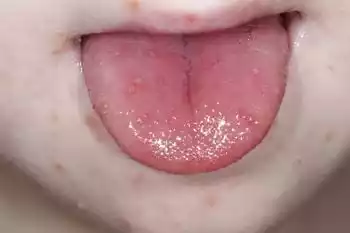Both Coxsackie and Kawasaki diseases are medical conditions that affect primarily children. Coxsackie virus is the cause of Coxsackie, whereas Kawasaki disease has a mysterious etiology that could involve autoimmune or infectious factors.
Understanding these diseases can help with accurate diagnosis and the right medical treatment. This overview will explore the main features, symptoms, and differences of these two conditions.
Overview of Coxsackie disease
Coxsackie virus infection is also known as Coxsackie Disease. It is a viral disease caused by the Coxsackievirus, a member of the Enterovirus family. This virus is primarily found in infants and young children, but it can also affect adults. Coxsackieviruses can be spread by person-to-person contacts, respiratory secretions, and contaminated surfaces.
This is a brief overview of Coxsackie Disease:
- Etiology and Classification:
-
- Coxsackie virus, which is a member of the Picornaviridae group, causes the disease.
- Coxsackieviruses are divided into two groups: Group A and Group B. Each group includes multiple serotypes.
- Hand, foot, and mouth disease and herpangina are usually associated with group A coxsackieviruses.
- The Group B Coxsackieviruses are responsible for a variety of diseases, including respiratory infections and myocarditis.
- Transmission:
-
- The Coxsackievirus is highly contagious. It spreads primarily through direct contact with saliva, respiratory secretions, or feces of an infected individual.
- Indirect transmission of the virus is possible through contaminated surfaces and objects.
- Clinical Present:
-
- The symptoms of Coxsackie can vary depending on the serotype, and how the immune system responds to the disease.
- Common symptoms include fatigue, headaches, sore throat and fever.
- Hand, foot, and mouth disease is a unique presentation characterized by fever, skin rashes, and oral ulcers on the feet and hands. Most commonly, it is caused by Coxsackievirus.
- Herpangina, a manifestation that includes a sore throat, fever, and painful mouth ulcers, is also a common condition.
- Complications:
-
- Coxsackie is usually self-limiting, but it can cause complications in certain cases.
- Heart problems can be caused by myocarditis or pericarditis. This is especially true when the virus in question is Group B.
- Aseptic meningitis can be caused by the involvement of the central nervous system.
- In severe cases of HFMD, secondary bacterial infections and dehydration can occur.
- Diagnosis:
-
- The diagnosis of Coxsackie is usually based on the clinical symptoms and a physical examination.
- Coxsackievirus can be confirmed in clinical samples by laboratory tests such as viral cultures, polymerase chain reaction (PCR), or serology.
- Treatment:
-
- As there is no antiviral medication, Coxsackie is treated symptomatically.
- The treatment focuses on relieving the symptoms, maintaining hydration, and providing pain relief.
- To prevent the spread of infection, it is essential to practice good hand hygiene and take isolation measures.
- Prevention:
-
- Handwashing is an important part of preventing Coxsackie, particularly after changing a baby’s diaper or taking care of someone who has been ill.
- As of September 2021, vaccines against certain enteroviruses including Coxsackievirus are currently being developed but not yet widely available.

Coxsackie is a virus illness that primarily affects children. Hand, foot, and mouth disease is one of its most common symptoms. Some people may develop complications, especially if the virus attacks the central nervous system or heart. Coxsackie is best controlled and prevented by following good hygiene and isolation practices.
Overview of Kawasaki disease
Kawasaki, or Kawasaki syndrome, or mucocutaneous node syndrome is a rare, but potentially severe autoimmune disorder that affects primarily children, especially those younger than five years old. In the 1960s, Dr.
This is a brief overview of Kawasaki Disease:
- Etiology of Pathogenesis:
-
- Kawasaki Disease is a condition that is not known to be caused by a specific cause but is thought to be autoimmune in nature.
- This condition can be caused by an infection, or an abnormal immune reaction to an unknown antigen.
- Clinical Present:
-
- Kawasaki is characterized as a cluster of symptoms. The most notable symptom is a fever that persists for at least 5 days.
- Other common clinical symptoms include:
-
-
- Hands and feet redness and swelling (erythema edema).
- Rash that is often peeling, and can progress from the trunk out to the extremities
- Conjunctivitis (red, bloodshot eyes)
- Swollen lymph glands, typically in the neck
- Strawberry tongue (bright, red tongue with prominent papillae).
- Young children who are irritable and extremely fussy
-
-
- Cardiac complications can be a major concern. These include coronary aneurysms and myocarditis.
- Diagnosis:
-
- The diagnosis of Kawasaki is based primarily on a set of characteristic symptoms.
- Blood tests can show elevated levels of inflammation markers, although no specific lab test can confirm the disease.
- The heart is assessed and abnormalities in coronary arteries are checked using echocardiography.
- Treatment:
-
- Early diagnosis and treatment are crucial to reducing the risk of coronary complications.
- Standard treatment for Kawasaki Disease involves:
-
-
- Intravenous immunoglobulin therapy (IVIG) helps to reduce inflammation and lowers the risk of coronary aneurysms.
- Aspirin high-dose therapy for fever and inflammation.
-
-
- Echocardiography monitoring is important. If coronary artery complications occur, further treatment may be needed.
- Prognosis:
-
- Most children who have Kawasaki disease will recover completely without any long-term complications if they receive prompt and appropriate treatment.
- The risk of coronary aneurysms is still a concern and a long-term monitoring program is required.
- Prevention:
-
- As the exact cause of Kawasaki is unknown, there is no known prevention for this disease.
- Early diagnosis and medical attention can prevent serious complications.

Kawasaki is a rare, but potentially severe autoimmune disease that affects primarily young children. The disease is characterized by a prolonged fever and a variety of clinical symptoms that affect the skin, mucous tissues, eyes, lymph nodes, etc. To reduce the risk of coronary artery complications, it is important to get a timely diagnosis and receive treatment. This usually involves IVIG and Aspirin. It is important to monitor the child’s heart regularly during and after the treatment. This will ensure that they have a positive outcome.
Coxsackie and Kawasaki Disease in the comparative chart
Here’s a comparative chart highlighting the key differences and some similarities between Coxsackie disease and Kawasaki disease:
| Feature | Coxsackie Disease | Kawasaki Disease |
| Etiology | Coxsackievirus (Enterovirus family) | Unknown, possibly autoimmune or infectious trigger |
| Age Group Affected | Primarily children | Primarily children under 5 years of age |
| Transmission | Highly contagious via respiratory secretions, feces, and direct contact | Not considered highly contagious; exact mode of transmission unknown |
| Clinical Presentation | Variable may include fever, sore throat, and characteristic symptoms such as hand, foot, and mouth symptoms | Persistent fever (>5 days), along with characteristic symptoms, including skin rash, conjunctivitis, swollen lymph nodes, and changes in the oral mucosa |
| Cardiac Involvement | Rare, except in some severe cases of Coxsackievirus B infections | Significant risk of coronary artery aneurysms and other cardiac complications |
| Neurological Complications | Aseptic meningitis in some cases | Not typically associated with neurological complications |
| Diagnosis | Clinical presentation, laboratory tests (viral culture, PCR) | Clinical criteria, blood tests (inflammatory markers), echocardiography |
| Treatment | Supportive care, antiviral medications (if applicable) | Intravenous immunoglobulin (IVIG) therapy, aspirin therapy, cardiac monitoring |
| Prevention | Hand hygiene, isolation precautions | Early recognition of symptoms, no known prevention methods |
| Prognosis | Usually self-limiting; complications rare | Favorable with prompt treatment; risk of coronary artery complications |
Importance of understanding the differences
There are several reasons why it is important to understand the differences between Coxsackie and Kawasaki diseases:
- Accurate Diagnosis & Treatment:
-
- The clinical presentation and treatment of Kawasaki and Coxsackie diseases are different. Understanding the differences can help healthcare professionals diagnose and treat their patients accurately, reducing the chance of a misdiagnosis or inappropriate treatment.
- Patient Safety:
-
- For patient safety, it is essential to diagnose and manage these diseases correctly. Untreated Kawasaki can cause severe cardiac complications. Coxsackie may also have its own complications. Understanding the differences will help you take appropriate measures to protect your patients’ health.
- Timely Intervening:
-
- Kawasaki disease must be treated promptly with intravenous immunoglobulin (IVIG), aspirin, and other medications to prevent coronary aneurysms. Early recognition of the signs and symptoms can reduce the risk of cardiovascular problems.
- Infection control:
-
- Coxsackie is highly contagious, and it can easily spread in healthcare facilities and communities. Understanding the unique characteristics of its transmission allows better infection control to reduce its spread.
- Public Health:
-
- It is important that public health officials and policymakers understand the differences between each of these diseases. This allows them to respond effectively to outbreaks and to allocate resources accordingly.
- Research and Vaccine Development:
-
- Research efforts are aided by a better understanding of the different etiologies, pathogenic mechanisms, and symptoms of Coxsackie disease and Kawasaki disease. In the future, this research could lead to the development and testing of vaccines and targeted therapies.
- Parental Awareness:
-
- By educating parents and caregivers on the differences between these illnesses, they can recognize symptoms and seek medical attention as soon as possible. They can also advocate for their child’s health.
- Medical Education:
-
- To provide the best care, healthcare professionals such as doctors, nurses, and medical students need to have a thorough understanding of these diseases. To ensure that healthcare providers are informed, medical education programs can benefit from teaching these differences.
- Reducing anxiety and misinformation:
-
- When faced with this disease, parents and patients have many questions and concerns. Communication about the differences between the two can help reduce anxiety and stop the spread of false information.
- Preparation and Prevention:
-
- Understanding the difference between Coxsackie disease and Kawasaki disease is essential for healthcare professionals to be prepared. Clinics and hospitals must be prepared to handle cases and prevent outbreaks.
Understanding the difference between Coxsackie and Kawasaki diseases is crucial for accurate diagnosis, timely treatments, patient safety, and effective public measures. This also helps support ongoing research and educates healthcare providers, parents, and the public about these diseases.
Similarities
There are some similarities between Coxsackie and Kawasaki diseases, despite the fact that they are two distinct illnesses, with different causes, symptoms, and treatments.
- Affects Children primarily:
-
- Both Coxsackie and Kawasaki diseases are primarily a disease of young children. Kawasaki is most common in children younger than 5.
- Fever is a common symptom:
-
- Fever is a common symptom of both diseases. In Kawasaki, the fever can last for more than five days, whereas it is a common symptom of Coxsackie.
- Pediatric Concerns:
-
- Pediatricians who are specialists in pediatrics will usually be involved in the diagnosis and treatment of these diseases.
- Importance of Early Diagnosis of Treatment:
-
- Both diseases are best treated early to avoid complications. Kawasaki disease can be treated with intravenous immunoglobulin and aspirin to prevent coronary aneurysms. If severe, Coxsackie may require supportive care as well as antiviral medication.
While there are similarities between the two diseases, they differ fundamentally in terms of their etiology and clinical manifestations. They also differ in terms of treatment methods, complications, as well as their complication rates. To provide the best care for affected individuals, it is important to differentiate and diagnose accurately.
What are the symptoms of Kawasaki Disease vs. Coxsackievirus?
Kawasaki Disease and Coxsackievirus (specifically, Coxsackie disease or infections caused by Coxsackieviruses) have distinct sets of symptoms.
Here, I’ll provide an overview of the typical symptoms associated with each of these conditions:
Symptoms of Kawasaki Disease:
- Persistent Fever: Kawasaki disease is characterized by a prolonged fever that typically lasts for at least five days and may persist for up to two weeks or longer.
- Conjunctivitis: Redness and inflammation of the whites of the eyes (conjunctivitis) are common symptoms, giving the eyes a bloodshot appearance.
- Rash: Children with Kawasaki disease often develop a rash, which can vary in appearance but is typically widespread and may be red or pink.
- Swollen Lymph Nodes: Swelling and redness of the lymph nodes, usually in the neck area, are common.
- Changes in the Oral Mucosa: Kawasaki disease can cause changes in the mouth, including a “strawberry tongue” (bright red tongue with prominent papillae), dry, cracked lips, and oral mucosal changes.
- Swelling of the Hands and Feet: Redness and swelling of the hands and feet (erythema and edema) are common in Kawasaki disease.
- Irritability and Fussiness: Young children with Kawasaki disease may be irritable, fussy, and generally unwell.
- Abdominal Symptoms: Some children may experience abdominal pain, diarrhea, vomiting, or other gastrointestinal symptoms.
- Cardiac Complications: Kawasaki disease can lead to serious cardiac complications, including coronary artery aneurysms, myocarditis, and other heart-related issues. Cardiac symptoms may not be immediately apparent.
Symptoms of Coxsackie Disease:
- Fever: Coxsackie disease often begins with a fever, which can be accompanied by other symptoms.
- Sore Throat: Children with Coxsackie infections may experience a sore throat, similar to symptoms of a common cold.
- Hand, Foot, and Mouth Symptoms: Coxsackie A16, a specific serotype of Coxsackievirus, commonly causes hand, foot, and mouth disease (HFMD). Symptoms include oral ulcers, skin rashes on the hands and feet, and sometimes buttock and genital area rashes.
- Rash: In addition to HFMD, other Coxsackievirus infections can cause rashes, which may vary in appearance.
- Mouth Ulcers: Ulcers may develop inside the mouth, which can be painful and uncomfortable.
- Headache and Fatigue: Children with Coxsackie infections may experience headaches and fatigue, similar to other viral illnesses.
- Cardiac Involvement (in some severe cases): While cardiac complications are not common in Coxsackie disease, severe Coxsackie B infections can lead to myocarditis and pericarditis, affecting the heart.
It’s important to note that both diseases can vary in their presentation, and not all individuals will experience all symptoms. Additionally, Kawasaki disease is a more serious condition that requires specific treatment with intravenous immunoglobulin (IVIG) and aspirin, whereas Coxsackie disease is typically managed symptomatically, with treatment aimed at relieving discomfort and fever. If you suspect either of these conditions in yourself or your child, seek prompt medical attention for an accurate diagnosis and appropriate care.
What Causes Coxsackievirus vs. Kawasaki virus?
Coxsackievirus:
Coxsackieviruses belong to a viral family called enterovirus. The viruses are grouped into two: group A and group B. Each group is divided further into different serotypes. The acid in the stomach does not destroy the virus, which can survive on surfaces for up to several hours.
Kawasaki Disease:
Kawasaki is a mysterious disease. Although there are many theories about the cause, none of them have been proven. Many believe the disease is an infection, as outbreaks tend to cluster and look similar to other infectious illnesses (abrupt onset of symptoms, fever, rapid resolution within 1-3 weeks). The disease is believed to be caused by bacterial toxins that act as a trigger. The toxin can be a result of bacterial infection, which is common in children.
Conclusion
Coxsackievirus can be caused by certain serotypes, which are members of the Picornaviridae virus family. The exact cause of Kawasaki is unknown but is thought to be triggered by autoimmune or viral triggers.

